LEGL300 Taxation Law Assignment: Income Tax Consequences Analysis
VerifiedAdded on 2023/06/03
|10
|2427
|446
Homework Assignment
AI Summary
This assignment solution addresses two key questions in taxation law. The first question involves calculating the taxable income of Racing Parts Pty Ltd for the year ended 2018, considering various income and expense items such as exempted income, non-assessable non-exempt income, depreciation, bad debts, provisions for leave, dividends, borrowing expenses, donations, and other deductible expenses. The second question focuses on the determination of income tax consequences arising from transactions incurred by a self-employed architect named John, including the sale of a residential property and an antique desk, home office deductions, fines, capital improvements, depreciation of assets, travel expenses, and car expenses. The solution applies relevant sections of the ITAA 1997 and supporting case law to provide a comprehensive analysis of the tax implications of each scenario, including capital gains tax and allowable deductions.
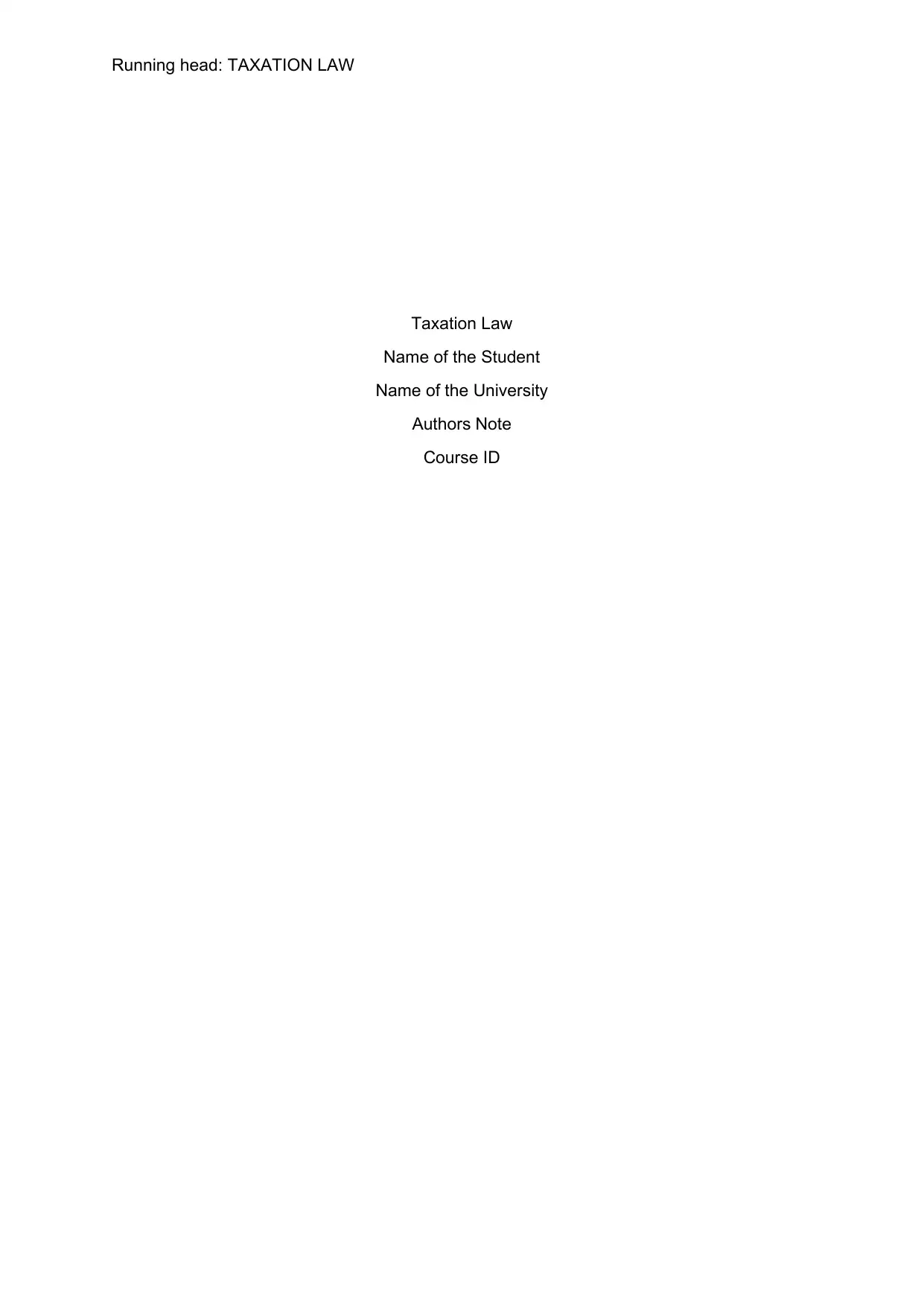
Running head: TAXATION LAW
Taxation Law
Name of the Student
Name of the University
Authors Note
Course ID
Taxation Law
Name of the Student
Name of the University
Authors Note
Course ID
Paraphrase This Document
Need a fresh take? Get an instant paraphrase of this document with our AI Paraphraser
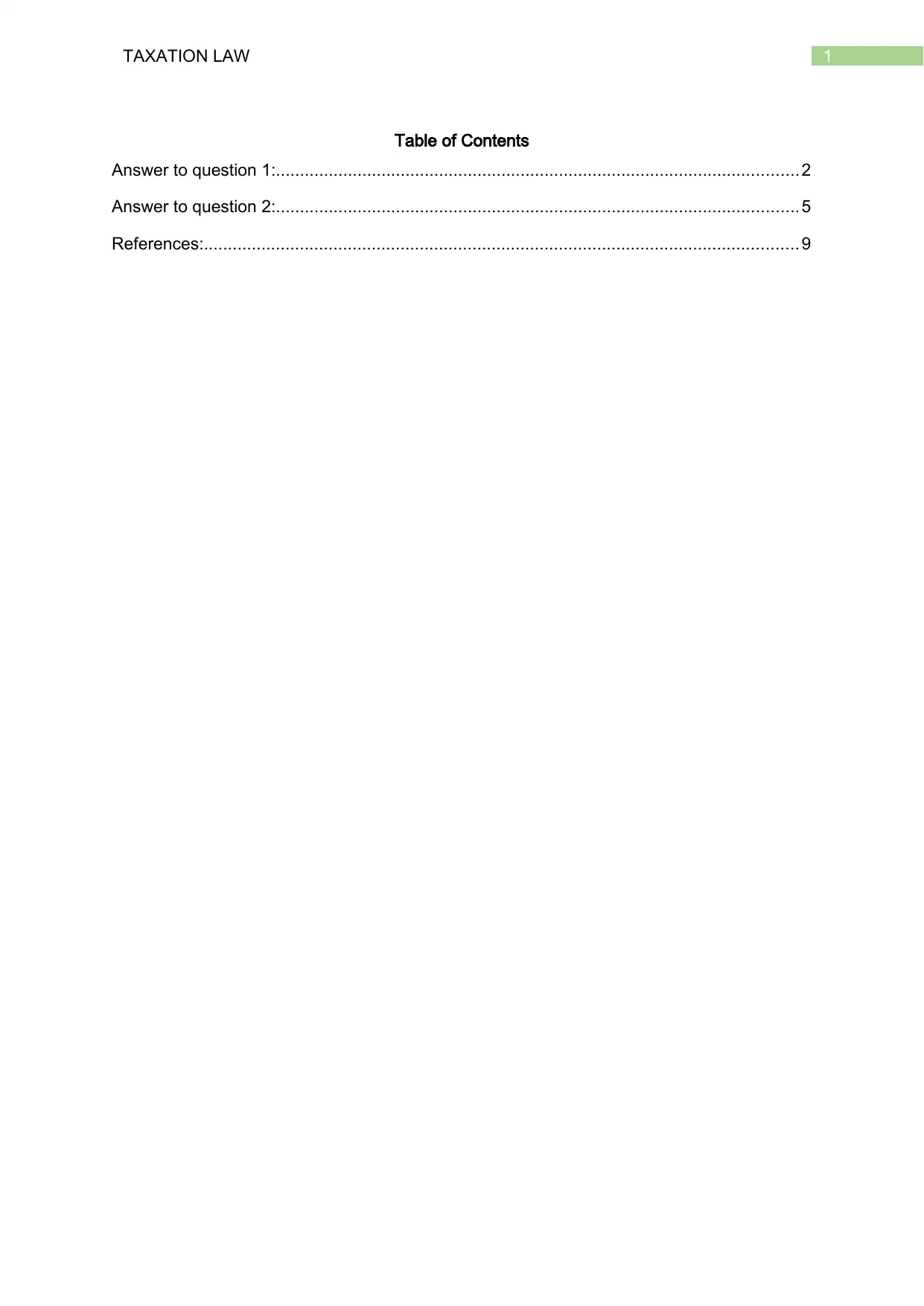
1TAXATION LAW
Table of Contents
Answer to question 1:............................................................................................................. 2
Answer to question 2:............................................................................................................. 5
References:............................................................................................................................ 9
Table of Contents
Answer to question 1:............................................................................................................. 2
Answer to question 2:............................................................................................................. 5
References:............................................................................................................................ 9
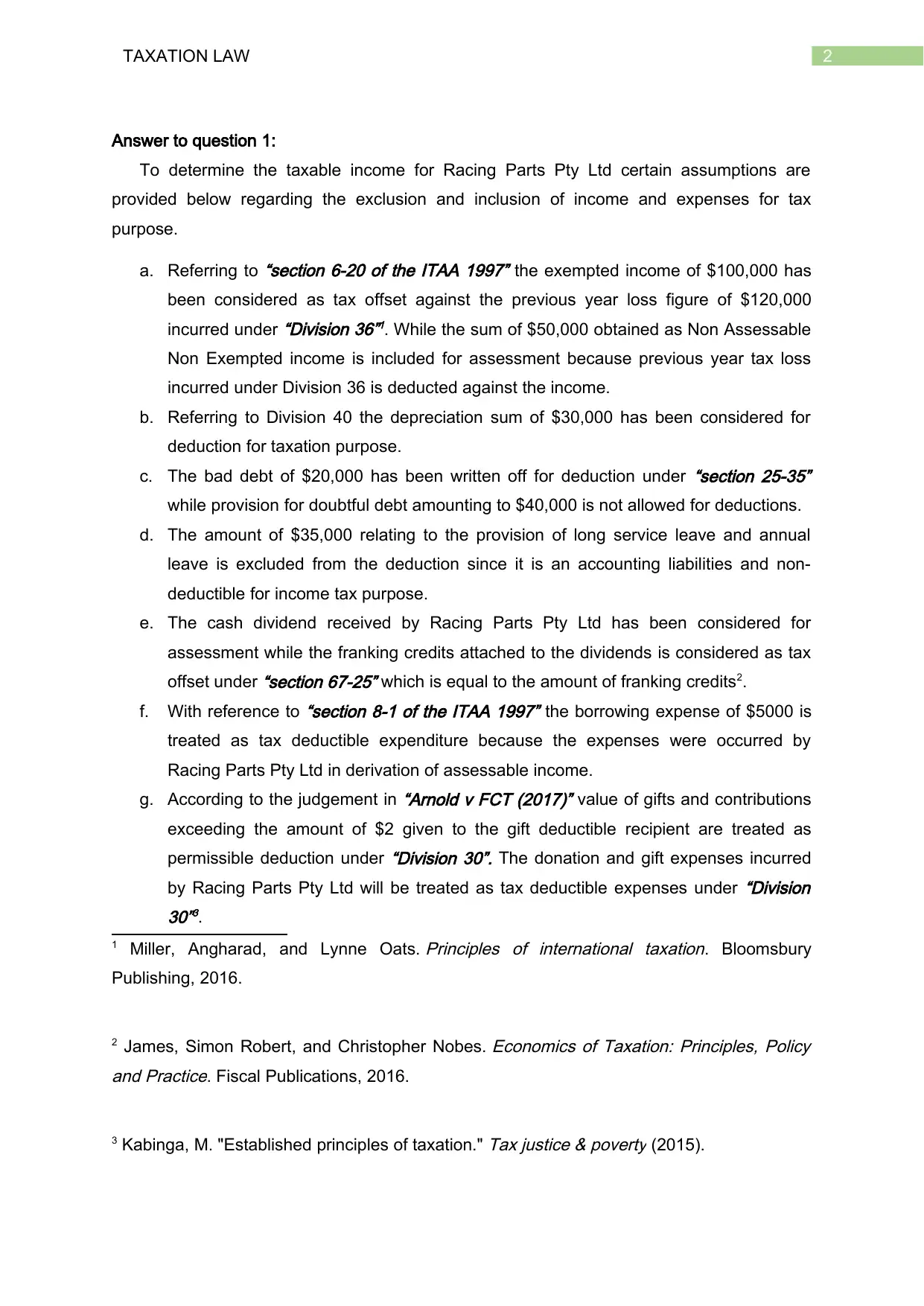
2TAXATION LAW
Answer to question 1:
To determine the taxable income for Racing Parts Pty Ltd certain assumptions are
provided below regarding the exclusion and inclusion of income and expenses for tax
purpose.
a. Referring to
“section 6-20 of the ITAA 1997” the exempted income of $100,000 has
been considered as tax offset against the previous year loss figure of $120,000
incurred under
“Division 36”1. While the sum of $50,000 obtained as Non Assessable
Non Exempted income is included for assessment because previous year tax loss
incurred under Division 36 is deducted against the income.
b. Referring to Division 40 the depreciation sum of $30,000 has been considered for
deduction for taxation purpose.
c. The bad debt of $20,000 has been written off for deduction under
“section 25-35”
while provision for doubtful debt amounting to $40,000 is not allowed for deductions.
d. The amount of $35,000 relating to the provision of long service leave and annual
leave is excluded from the deduction since it is an accounting liabilities and non-
deductible for income tax purpose.
e. The cash dividend received by Racing Parts Pty Ltd has been considered for
assessment while the franking credits attached to the dividends is considered as tax
offset under
“section 67-25” which is equal to the amount of franking credits2.
f. With reference to
“section 8-1 of the ITAA 1997” the borrowing expense of $5000 is
treated as tax deductible expenditure because the expenses were occurred by
Racing Parts Pty Ltd in derivation of assessable income.
g. According to the judgement in
“Arnold v FCT (2017)” value of gifts and contributions
exceeding the amount of $2 given to the gift deductible recipient are treated as
permissible deduction under
“Division 30”. The donation and gift expenses incurred
by Racing Parts Pty Ltd will be treated as tax deductible expenses under
“Division
30”3.
1 Miller, Angharad, and Lynne Oats.
Principles of international taxation. Bloomsbury
Publishing, 2016.
2 James, Simon Robert, and Christopher Nobes.
Economics of Taxation: Principles, Policy
and Practice. Fiscal Publications, 2016.
3 Kabinga, M. "Established principles of taxation."
Tax justice & poverty (2015).
Answer to question 1:
To determine the taxable income for Racing Parts Pty Ltd certain assumptions are
provided below regarding the exclusion and inclusion of income and expenses for tax
purpose.
a. Referring to
“section 6-20 of the ITAA 1997” the exempted income of $100,000 has
been considered as tax offset against the previous year loss figure of $120,000
incurred under
“Division 36”1. While the sum of $50,000 obtained as Non Assessable
Non Exempted income is included for assessment because previous year tax loss
incurred under Division 36 is deducted against the income.
b. Referring to Division 40 the depreciation sum of $30,000 has been considered for
deduction for taxation purpose.
c. The bad debt of $20,000 has been written off for deduction under
“section 25-35”
while provision for doubtful debt amounting to $40,000 is not allowed for deductions.
d. The amount of $35,000 relating to the provision of long service leave and annual
leave is excluded from the deduction since it is an accounting liabilities and non-
deductible for income tax purpose.
e. The cash dividend received by Racing Parts Pty Ltd has been considered for
assessment while the franking credits attached to the dividends is considered as tax
offset under
“section 67-25” which is equal to the amount of franking credits2.
f. With reference to
“section 8-1 of the ITAA 1997” the borrowing expense of $5000 is
treated as tax deductible expenditure because the expenses were occurred by
Racing Parts Pty Ltd in derivation of assessable income.
g. According to the judgement in
“Arnold v FCT (2017)” value of gifts and contributions
exceeding the amount of $2 given to the gift deductible recipient are treated as
permissible deduction under
“Division 30”. The donation and gift expenses incurred
by Racing Parts Pty Ltd will be treated as tax deductible expenses under
“Division
30”3.
1 Miller, Angharad, and Lynne Oats.
Principles of international taxation. Bloomsbury
Publishing, 2016.
2 James, Simon Robert, and Christopher Nobes.
Economics of Taxation: Principles, Policy
and Practice. Fiscal Publications, 2016.
3 Kabinga, M. "Established principles of taxation."
Tax justice & poverty (2015).
⊘ This is a preview!⊘
Do you want full access?
Subscribe today to unlock all pages.

Trusted by 1+ million students worldwide
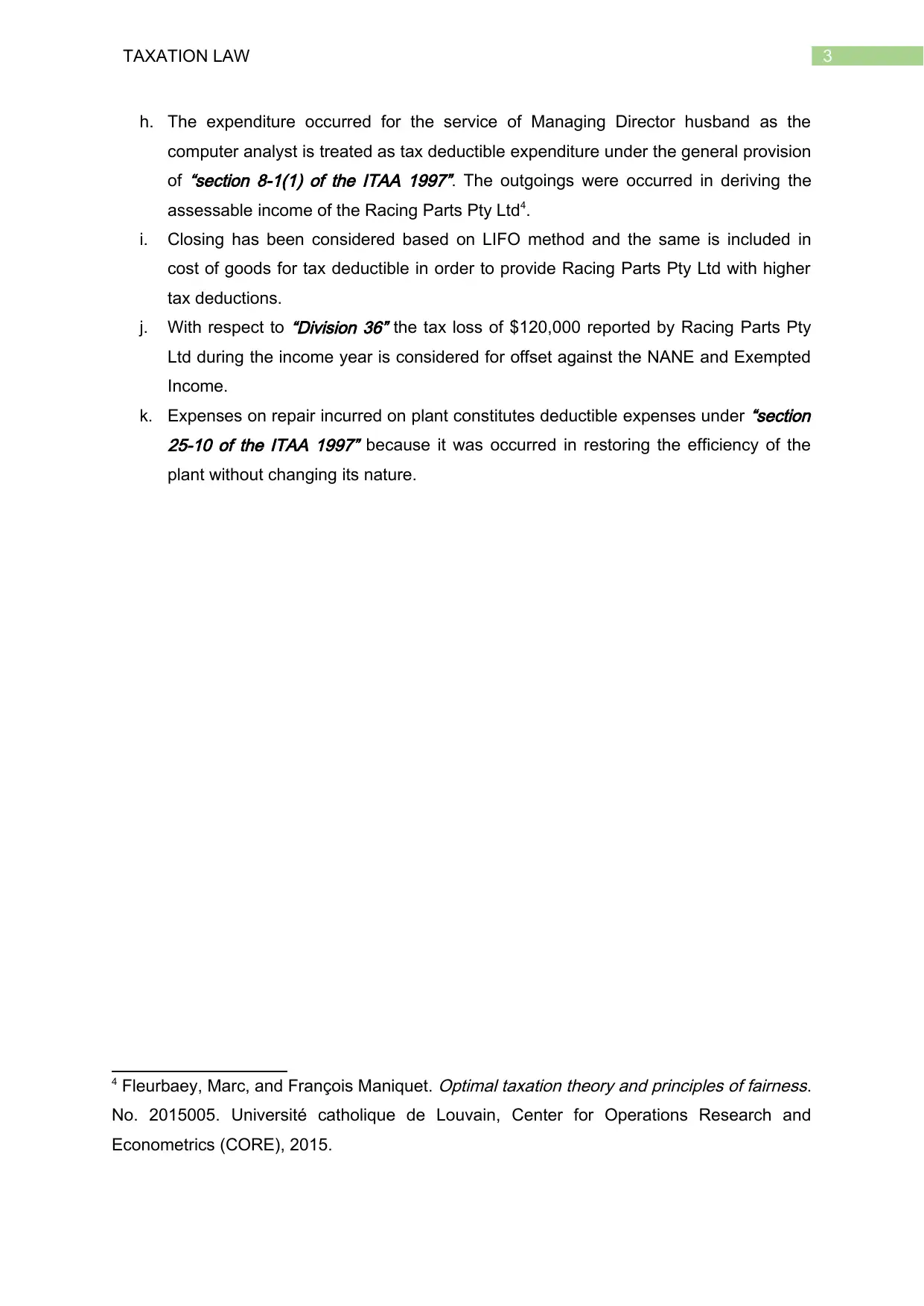
3TAXATION LAW
h. The expenditure occurred for the service of Managing Director husband as the
computer analyst is treated as tax deductible expenditure under the general provision
of
“section 8-1(1) of the ITAA 1997”. The outgoings were occurred in deriving the
assessable income of the Racing Parts Pty Ltd4.
i. Closing has been considered based on LIFO method and the same is included in
cost of goods for tax deductible in order to provide Racing Parts Pty Ltd with higher
tax deductions.
j. With respect to
“Division 36” the tax loss of $120,000 reported by Racing Parts Pty
Ltd during the income year is considered for offset against the NANE and Exempted
Income.
k. Expenses on repair incurred on plant constitutes deductible expenses under
“section
25-10 of the ITAA 1997” because it was occurred in restoring the efficiency of the
plant without changing its nature.
4 Fleurbaey, Marc, and François Maniquet.
Optimal taxation theory and principles of fairness.
No. 2015005. Université catholique de Louvain, Center for Operations Research and
Econometrics (CORE), 2015.
h. The expenditure occurred for the service of Managing Director husband as the
computer analyst is treated as tax deductible expenditure under the general provision
of
“section 8-1(1) of the ITAA 1997”. The outgoings were occurred in deriving the
assessable income of the Racing Parts Pty Ltd4.
i. Closing has been considered based on LIFO method and the same is included in
cost of goods for tax deductible in order to provide Racing Parts Pty Ltd with higher
tax deductions.
j. With respect to
“Division 36” the tax loss of $120,000 reported by Racing Parts Pty
Ltd during the income year is considered for offset against the NANE and Exempted
Income.
k. Expenses on repair incurred on plant constitutes deductible expenses under
“section
25-10 of the ITAA 1997” because it was occurred in restoring the efficiency of the
plant without changing its nature.
4 Fleurbaey, Marc, and François Maniquet.
Optimal taxation theory and principles of fairness.
No. 2015005. Université catholique de Louvain, Center for Operations Research and
Econometrics (CORE), 2015.
Paraphrase This Document
Need a fresh take? Get an instant paraphrase of this document with our AI Paraphraser
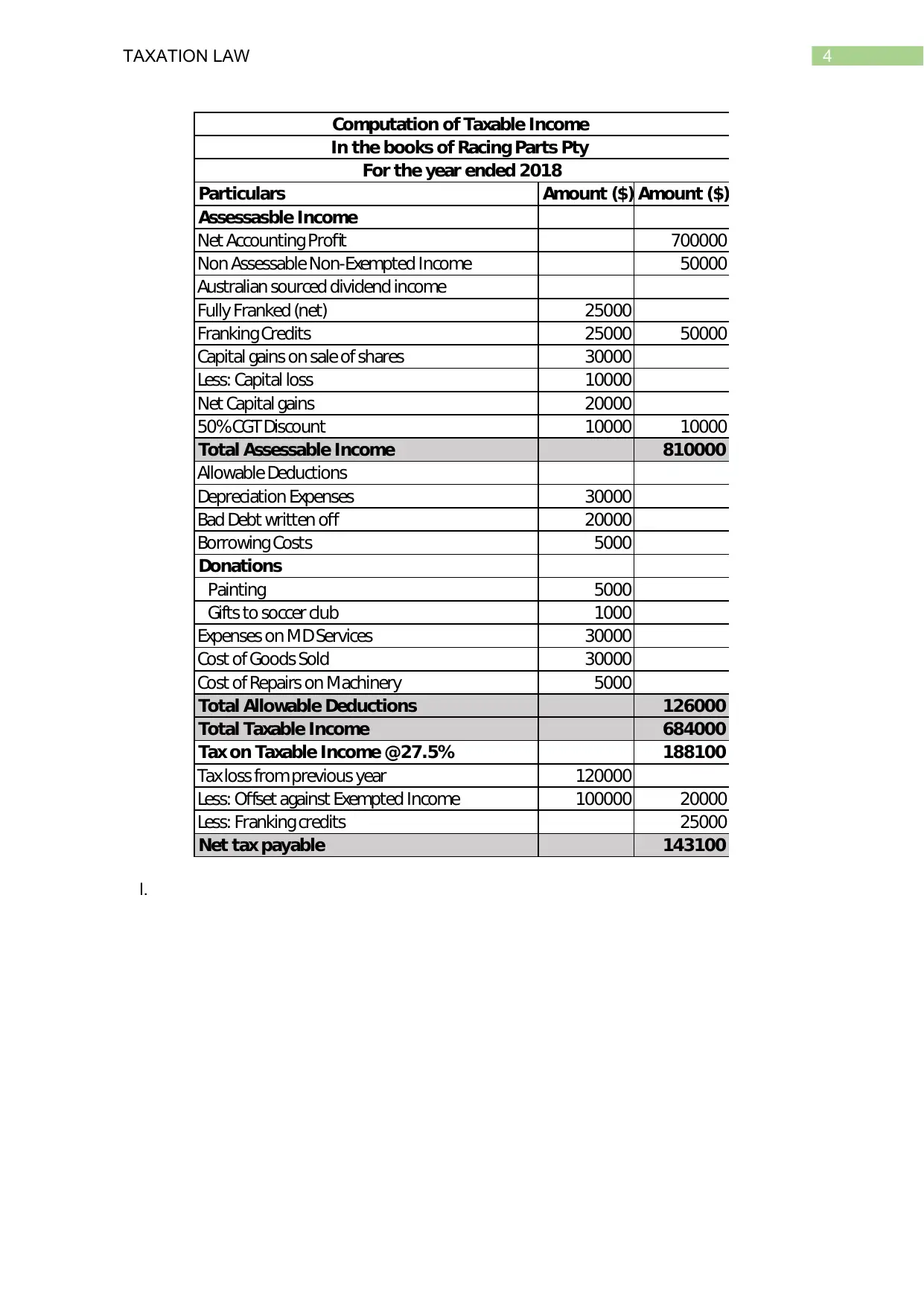
4TAXATION LAW
Particulars Amount ($) Amount ($)
Assessasble Income
Net Accounting Profit 700000
Non Assessable Non-Exempted Income 50000
Australian sourced dividend income
Fully Franked (net) 25000
FrankingCredits 25000 50000
Capital gains on sale of shares 30000
Less: Capital loss 10000
Net Capital gains 20000
50%CGT Discount 10000 10000
Total Assessable Income 810000
Allowable Deductions
Depreciation Expenses 30000
Bad Debt written off 20000
Borrowing Costs 5000
Donations
Painting 5000
Gifts to soccer club 1000
Expenses on MDServices 30000
Cost of Goods Sold 30000
Cost of Repairs on Machinery 5000
Total Allowable Deductions 126000
Total Taxable Income 684000
Tax on Taxable Income @27.5% 188100
Taxloss fromprevious year 120000
Less: Offset against Exempted Income 100000 20000
Less: Frankingcredits 25000
Net tax payable 143100
Computation of Taxable Income
In the books of Racing Parts Pty
For the year ended 2018
l.
Particulars Amount ($) Amount ($)
Assessasble Income
Net Accounting Profit 700000
Non Assessable Non-Exempted Income 50000
Australian sourced dividend income
Fully Franked (net) 25000
FrankingCredits 25000 50000
Capital gains on sale of shares 30000
Less: Capital loss 10000
Net Capital gains 20000
50%CGT Discount 10000 10000
Total Assessable Income 810000
Allowable Deductions
Depreciation Expenses 30000
Bad Debt written off 20000
Borrowing Costs 5000
Donations
Painting 5000
Gifts to soccer club 1000
Expenses on MDServices 30000
Cost of Goods Sold 30000
Cost of Repairs on Machinery 5000
Total Allowable Deductions 126000
Total Taxable Income 684000
Tax on Taxable Income @27.5% 188100
Taxloss fromprevious year 120000
Less: Offset against Exempted Income 100000 20000
Less: Frankingcredits 25000
Net tax payable 143100
Computation of Taxable Income
In the books of Racing Parts Pty
For the year ended 2018
l.
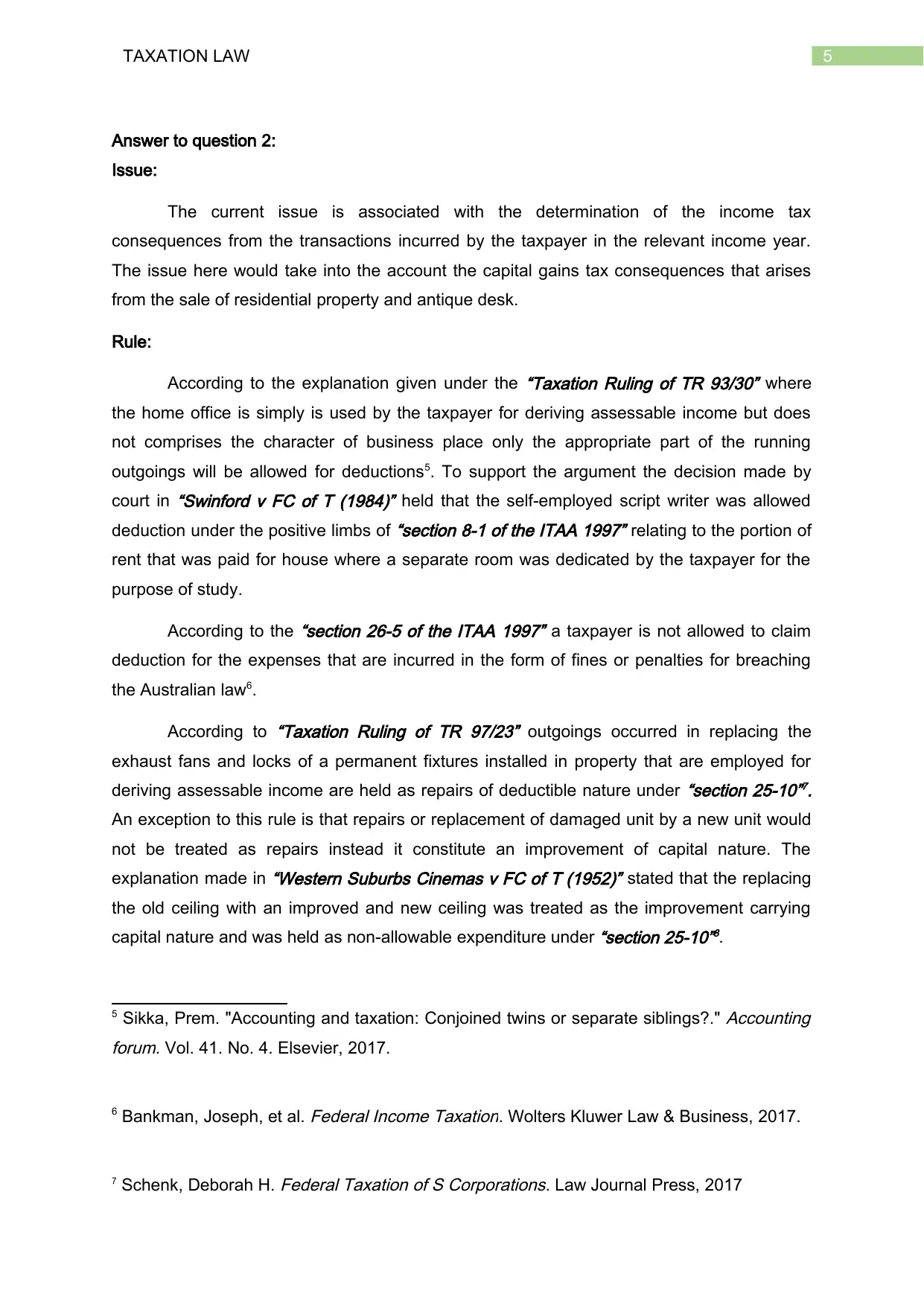
5TAXATION LAW
Answer to question 2:
Issue:
The current issue is associated with the determination of the income tax
consequences from the transactions incurred by the taxpayer in the relevant income year.
The issue here would take into the account the capital gains tax consequences that arises
from the sale of residential property and antique desk.
Rule:
According to the explanation given under the
“Taxation Ruling of TR 93/30” where
the home office is simply is used by the taxpayer for deriving assessable income but does
not comprises the character of business place only the appropriate part of the running
outgoings will be allowed for deductions5. To support the argument the decision made by
court in
“Swinford v FC of T (1984)” held that the self-employed script writer was allowed
deduction under the positive limbs of
“section 8-1 of the ITAA 1997” relating to the portion of
rent that was paid for house where a separate room was dedicated by the taxpayer for the
purpose of study.
According to the
“section 26-5 of the ITAA 1997” a taxpayer is not allowed to claim
deduction for the expenses that are incurred in the form of fines or penalties for breaching
the Australian law6.
According to
“Taxation Ruling of TR 97/23” outgoings occurred in replacing the
exhaust fans and locks of a permanent fixtures installed in property that are employed for
deriving assessable income are held as repairs of deductible nature under
“section 25-10”7.
An exception to this rule is that repairs or replacement of damaged unit by a new unit would
not be treated as repairs instead it constitute an improvement of capital nature. The
explanation made in
“Western Suburbs Cinemas v FC of T (1952)” stated that the replacing
the old ceiling with an improved and new ceiling was treated as the improvement carrying
capital nature and was held as non-allowable expenditure under
“section 25-10”8.
5 Sikka, Prem. "Accounting and taxation: Conjoined twins or separate siblings?."
Accounting
forum. Vol. 41. No. 4. Elsevier, 2017.
6 Bankman, Joseph, et al.
Federal Income Taxation. Wolters Kluwer Law & Business, 2017.
7 Schenk, Deborah H.
Federal Taxation of S Corporations. Law Journal Press, 2017
Answer to question 2:
Issue:
The current issue is associated with the determination of the income tax
consequences from the transactions incurred by the taxpayer in the relevant income year.
The issue here would take into the account the capital gains tax consequences that arises
from the sale of residential property and antique desk.
Rule:
According to the explanation given under the
“Taxation Ruling of TR 93/30” where
the home office is simply is used by the taxpayer for deriving assessable income but does
not comprises the character of business place only the appropriate part of the running
outgoings will be allowed for deductions5. To support the argument the decision made by
court in
“Swinford v FC of T (1984)” held that the self-employed script writer was allowed
deduction under the positive limbs of
“section 8-1 of the ITAA 1997” relating to the portion of
rent that was paid for house where a separate room was dedicated by the taxpayer for the
purpose of study.
According to the
“section 26-5 of the ITAA 1997” a taxpayer is not allowed to claim
deduction for the expenses that are incurred in the form of fines or penalties for breaching
the Australian law6.
According to
“Taxation Ruling of TR 97/23” outgoings occurred in replacing the
exhaust fans and locks of a permanent fixtures installed in property that are employed for
deriving assessable income are held as repairs of deductible nature under
“section 25-10”7.
An exception to this rule is that repairs or replacement of damaged unit by a new unit would
not be treated as repairs instead it constitute an improvement of capital nature. The
explanation made in
“Western Suburbs Cinemas v FC of T (1952)” stated that the replacing
the old ceiling with an improved and new ceiling was treated as the improvement carrying
capital nature and was held as non-allowable expenditure under
“section 25-10”8.
5 Sikka, Prem. "Accounting and taxation: Conjoined twins or separate siblings?."
Accounting
forum. Vol. 41. No. 4. Elsevier, 2017.
6 Bankman, Joseph, et al.
Federal Income Taxation. Wolters Kluwer Law & Business, 2017.
7 Schenk, Deborah H.
Federal Taxation of S Corporations. Law Journal Press, 2017
⊘ This is a preview!⊘
Do you want full access?
Subscribe today to unlock all pages.

Trusted by 1+ million students worldwide
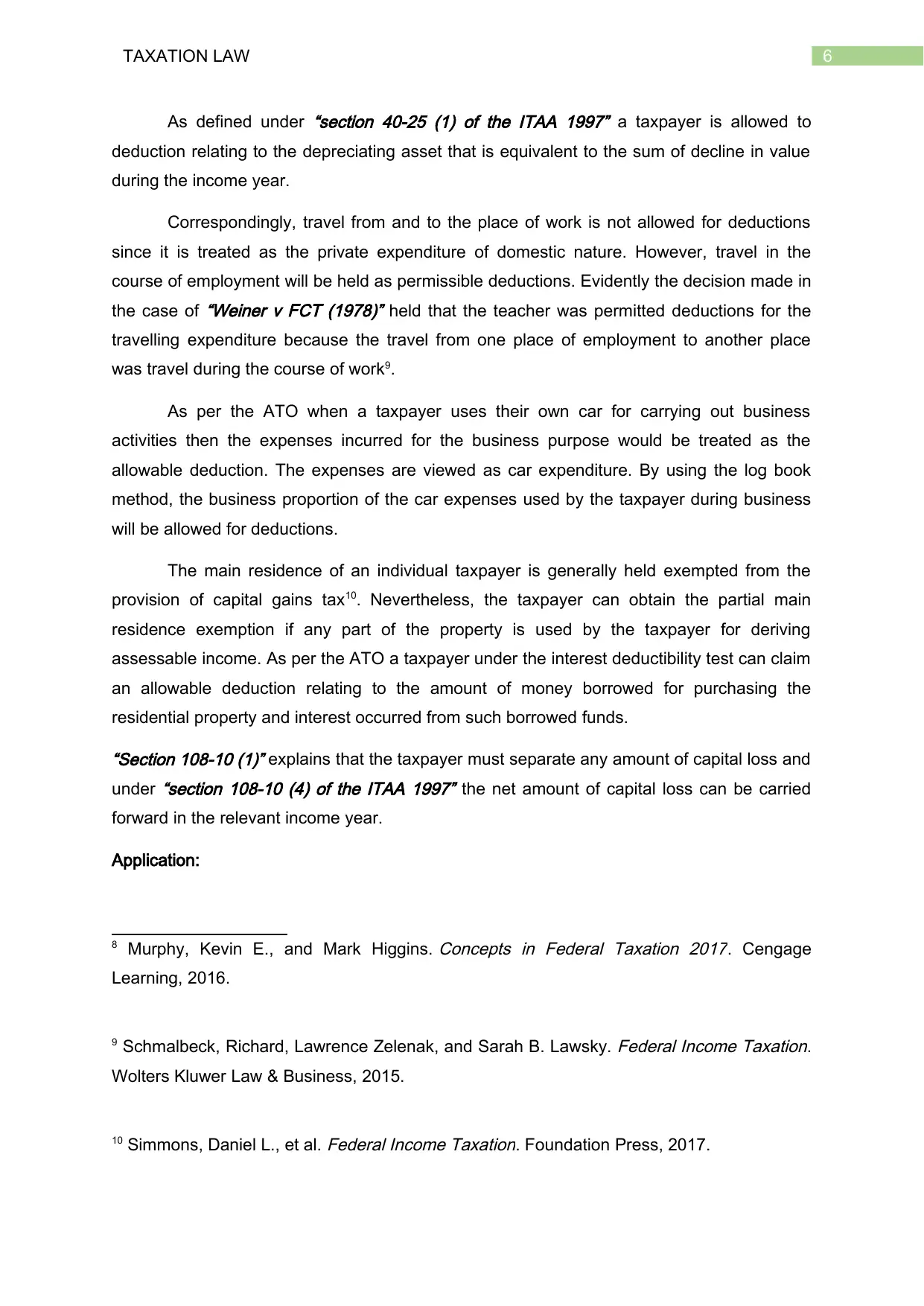
6TAXATION LAW
As defined under
“section 40-25 (1) of the ITAA 1997” a taxpayer is allowed to
deduction relating to the depreciating asset that is equivalent to the sum of decline in value
during the income year.
Correspondingly, travel from and to the place of work is not allowed for deductions
since it is treated as the private expenditure of domestic nature. However, travel in the
course of employment will be held as permissible deductions. Evidently the decision made in
the case of
“Weiner v FCT (1978)” held that the teacher was permitted deductions for the
travelling expenditure because the travel from one place of employment to another place
was travel during the course of work9.
As per the ATO when a taxpayer uses their own car for carrying out business
activities then the expenses incurred for the business purpose would be treated as the
allowable deduction. The expenses are viewed as car expenditure. By using the log book
method, the business proportion of the car expenses used by the taxpayer during business
will be allowed for deductions.
The main residence of an individual taxpayer is generally held exempted from the
provision of capital gains tax10. Nevertheless, the taxpayer can obtain the partial main
residence exemption if any part of the property is used by the taxpayer for deriving
assessable income. As per the ATO a taxpayer under the interest deductibility test can claim
an allowable deduction relating to the amount of money borrowed for purchasing the
residential property and interest occurred from such borrowed funds.
“Section 108-10 (1)” explains that the taxpayer must separate any amount of capital loss and
under
“section 108-10 (4) of the ITAA 1997” the net amount of capital loss can be carried
forward in the relevant income year.
Application:
8 Murphy, Kevin E., and Mark Higgins.
Concepts in Federal Taxation 2017. Cengage
Learning, 2016.
9 Schmalbeck, Richard, Lawrence Zelenak, and Sarah B. Lawsky.
Federal Income Taxation.
Wolters Kluwer Law & Business, 2015.
10 Simmons, Daniel L., et al.
Federal Income Taxation. Foundation Press, 2017.
As defined under
“section 40-25 (1) of the ITAA 1997” a taxpayer is allowed to
deduction relating to the depreciating asset that is equivalent to the sum of decline in value
during the income year.
Correspondingly, travel from and to the place of work is not allowed for deductions
since it is treated as the private expenditure of domestic nature. However, travel in the
course of employment will be held as permissible deductions. Evidently the decision made in
the case of
“Weiner v FCT (1978)” held that the teacher was permitted deductions for the
travelling expenditure because the travel from one place of employment to another place
was travel during the course of work9.
As per the ATO when a taxpayer uses their own car for carrying out business
activities then the expenses incurred for the business purpose would be treated as the
allowable deduction. The expenses are viewed as car expenditure. By using the log book
method, the business proportion of the car expenses used by the taxpayer during business
will be allowed for deductions.
The main residence of an individual taxpayer is generally held exempted from the
provision of capital gains tax10. Nevertheless, the taxpayer can obtain the partial main
residence exemption if any part of the property is used by the taxpayer for deriving
assessable income. As per the ATO a taxpayer under the interest deductibility test can claim
an allowable deduction relating to the amount of money borrowed for purchasing the
residential property and interest occurred from such borrowed funds.
“Section 108-10 (1)” explains that the taxpayer must separate any amount of capital loss and
under
“section 108-10 (4) of the ITAA 1997” the net amount of capital loss can be carried
forward in the relevant income year.
Application:
8 Murphy, Kevin E., and Mark Higgins.
Concepts in Federal Taxation 2017. Cengage
Learning, 2016.
9 Schmalbeck, Richard, Lawrence Zelenak, and Sarah B. Lawsky.
Federal Income Taxation.
Wolters Kluwer Law & Business, 2015.
10 Simmons, Daniel L., et al.
Federal Income Taxation. Foundation Press, 2017.
Paraphrase This Document
Need a fresh take? Get an instant paraphrase of this document with our AI Paraphraser
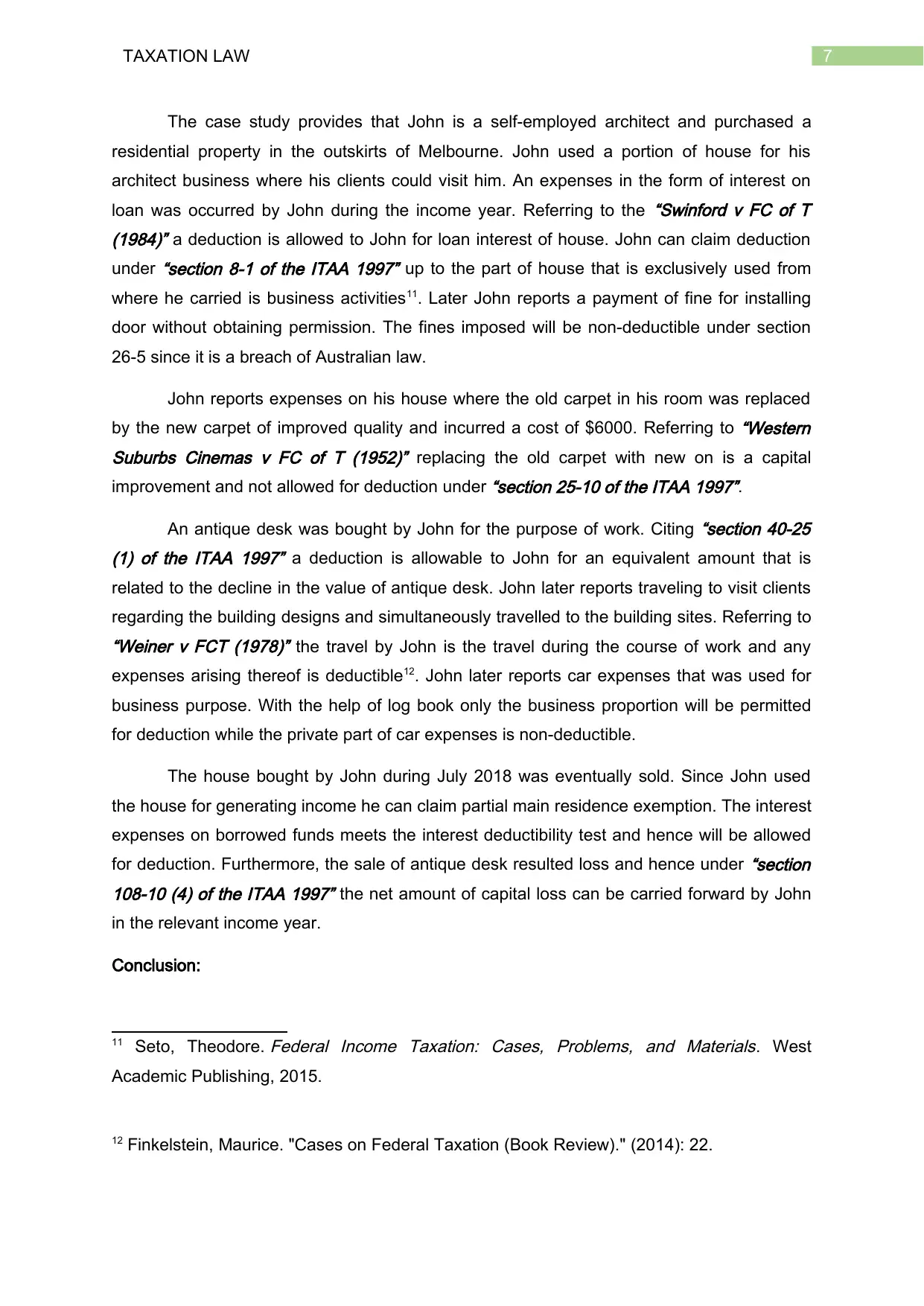
7TAXATION LAW
The case study provides that John is a self-employed architect and purchased a
residential property in the outskirts of Melbourne. John used a portion of house for his
architect business where his clients could visit him. An expenses in the form of interest on
loan was occurred by John during the income year. Referring to the
“Swinford v FC of T
(1984)” a deduction is allowed to John for loan interest of house. John can claim deduction
under
“section 8-1 of the ITAA 1997” up to the part of house that is exclusively used from
where he carried is business activities11. Later John reports a payment of fine for installing
door without obtaining permission. The fines imposed will be non-deductible under section
26-5 since it is a breach of Australian law.
John reports expenses on his house where the old carpet in his room was replaced
by the new carpet of improved quality and incurred a cost of $6000. Referring to
“Western
Suburbs Cinemas v FC of T (1952)” replacing the old carpet with new on is a capital
improvement and not allowed for deduction under
“section 25-10 of the ITAA 1997”.
An antique desk was bought by John for the purpose of work. Citing
“section 40-25
(1) of the ITAA 1997” a deduction is allowable to John for an equivalent amount that is
related to the decline in the value of antique desk. John later reports traveling to visit clients
regarding the building designs and simultaneously travelled to the building sites. Referring to“Weiner v FCT (1978)” the travel by John is the travel during the course of work and any
expenses arising thereof is deductible12. John later reports car expenses that was used for
business purpose. With the help of log book only the business proportion will be permitted
for deduction while the private part of car expenses is non-deductible.
The house bought by John during July 2018 was eventually sold. Since John used
the house for generating income he can claim partial main residence exemption. The interest
expenses on borrowed funds meets the interest deductibility test and hence will be allowed
for deduction. Furthermore, the sale of antique desk resulted loss and hence under
“section
108-10 (4) of the ITAA 1997” the net amount of capital loss can be carried forward by John
in the relevant income year.
Conclusion:
11 Seto, Theodore.
Federal Income Taxation: Cases, Problems, and Materials. West
Academic Publishing, 2015.
12 Finkelstein, Maurice. "Cases on Federal Taxation (Book Review)." (2014): 22.
The case study provides that John is a self-employed architect and purchased a
residential property in the outskirts of Melbourne. John used a portion of house for his
architect business where his clients could visit him. An expenses in the form of interest on
loan was occurred by John during the income year. Referring to the
“Swinford v FC of T
(1984)” a deduction is allowed to John for loan interest of house. John can claim deduction
under
“section 8-1 of the ITAA 1997” up to the part of house that is exclusively used from
where he carried is business activities11. Later John reports a payment of fine for installing
door without obtaining permission. The fines imposed will be non-deductible under section
26-5 since it is a breach of Australian law.
John reports expenses on his house where the old carpet in his room was replaced
by the new carpet of improved quality and incurred a cost of $6000. Referring to
“Western
Suburbs Cinemas v FC of T (1952)” replacing the old carpet with new on is a capital
improvement and not allowed for deduction under
“section 25-10 of the ITAA 1997”.
An antique desk was bought by John for the purpose of work. Citing
“section 40-25
(1) of the ITAA 1997” a deduction is allowable to John for an equivalent amount that is
related to the decline in the value of antique desk. John later reports traveling to visit clients
regarding the building designs and simultaneously travelled to the building sites. Referring to“Weiner v FCT (1978)” the travel by John is the travel during the course of work and any
expenses arising thereof is deductible12. John later reports car expenses that was used for
business purpose. With the help of log book only the business proportion will be permitted
for deduction while the private part of car expenses is non-deductible.
The house bought by John during July 2018 was eventually sold. Since John used
the house for generating income he can claim partial main residence exemption. The interest
expenses on borrowed funds meets the interest deductibility test and hence will be allowed
for deduction. Furthermore, the sale of antique desk resulted loss and hence under
“section
108-10 (4) of the ITAA 1997” the net amount of capital loss can be carried forward by John
in the relevant income year.
Conclusion:
11 Seto, Theodore.
Federal Income Taxation: Cases, Problems, and Materials. West
Academic Publishing, 2015.
12 Finkelstein, Maurice. "Cases on Federal Taxation (Book Review)." (2014): 22.

8TAXATION LAW
On a conclusive note, a deduction will be allowed to John incurred for home office
purpose but john cannot claim any deduction for capital expenses. Similarly a partial main
residence exemption can be claimed by John as the property was partially used for
generating income.
On a conclusive note, a deduction will be allowed to John incurred for home office
purpose but john cannot claim any deduction for capital expenses. Similarly a partial main
residence exemption can be claimed by John as the property was partially used for
generating income.
⊘ This is a preview!⊘
Do you want full access?
Subscribe today to unlock all pages.

Trusted by 1+ million students worldwide

9TAXATION LAW
References:
Bankman, Joseph, et al.
Federal Income Taxation. Wolters Kluwer Law & Business, 2017.
Finkelstein, Maurice. "Cases on Federal Taxation (Book Review)." (2014): 22.
Fleurbaey, Marc, and François Maniquet.
Optimal taxation theory and principles of fairness.
No. 2015005. Université catholique de Louvain, Center for Operations Research and
Econometrics (CORE), 2015.
James, Simon Robert, and Christopher Nobes.
Economics of Taxation: Principles, Policy
and Practice. Fiscal Publications, 2016.
Kabinga, M. "Established principles of taxation."
Tax justice & poverty (2015).
Miller, Angharad, and Lynne Oats.
Principles of international taxation. Bloomsbury
Publishing, 2016.
Murphy, Kevin E., and Mark Higgins.
Concepts in Federal Taxation 2017. Cengage
Learning, 2016.
Schenk, Deborah H.
Federal Taxation of S Corporations. Law Journal Press, 2017.
Schmalbeck, Richard, Lawrence Zelenak, and Sarah B. Lawsky.
Federal Income Taxation.
Wolters Kluwer Law & Business, 2015.
Seto, Theodore.
Federal Income Taxation: Cases, Problems, and Materials. West Academic
Publishing, 2015.
Sikka, Prem. "Accounting and taxation: Conjoined twins or separate siblings?."
Accounting
forum. Vol. 41. No. 4. Elsevier, 2017.
Simmons, Daniel L., et al.
Federal Income Taxation. Foundation Press, 2017.
References:
Bankman, Joseph, et al.
Federal Income Taxation. Wolters Kluwer Law & Business, 2017.
Finkelstein, Maurice. "Cases on Federal Taxation (Book Review)." (2014): 22.
Fleurbaey, Marc, and François Maniquet.
Optimal taxation theory and principles of fairness.
No. 2015005. Université catholique de Louvain, Center for Operations Research and
Econometrics (CORE), 2015.
James, Simon Robert, and Christopher Nobes.
Economics of Taxation: Principles, Policy
and Practice. Fiscal Publications, 2016.
Kabinga, M. "Established principles of taxation."
Tax justice & poverty (2015).
Miller, Angharad, and Lynne Oats.
Principles of international taxation. Bloomsbury
Publishing, 2016.
Murphy, Kevin E., and Mark Higgins.
Concepts in Federal Taxation 2017. Cengage
Learning, 2016.
Schenk, Deborah H.
Federal Taxation of S Corporations. Law Journal Press, 2017.
Schmalbeck, Richard, Lawrence Zelenak, and Sarah B. Lawsky.
Federal Income Taxation.
Wolters Kluwer Law & Business, 2015.
Seto, Theodore.
Federal Income Taxation: Cases, Problems, and Materials. West Academic
Publishing, 2015.
Sikka, Prem. "Accounting and taxation: Conjoined twins or separate siblings?."
Accounting
forum. Vol. 41. No. 4. Elsevier, 2017.
Simmons, Daniel L., et al.
Federal Income Taxation. Foundation Press, 2017.
1 out of 10
Related Documents
Your All-in-One AI-Powered Toolkit for Academic Success.
+13062052269
info@desklib.com
Available 24*7 on WhatsApp / Email
![[object Object]](/_next/static/media/star-bottom.7253800d.svg)
Unlock your academic potential
© 2024 | Zucol Services PVT LTD | All rights reserved.




